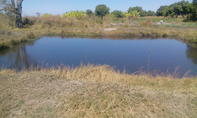There are three main events in the tilapia farming timeline: breeding fingerlings, growing out and harvesting, as well as processing the yield. Not all of these activities are always done on an aquaculture farm, except on the largest commercial tilapia farms.

Dedicated hatcheries produce high-quality fingerling stock. Grow-out units may be situated in the Lowveld or remote areas while processing of fish is often very basic with fish sold at the farm gate.
Rural farms situated in community areas will find a local market for small fresh fish. Those closer to larger urban centres may find a more sophisticated market that may demand red tilapia, gutted, gilled and scaled fish or even tilapia fillets.
Breeding Tilapia Fingerlings
Breeding tilapia, like any sophisticated stock enhancement program, demands specialised facilities. The days of home-breeding mixed-sex fingerlings are long gone, and should be, and dedicated hatcheries now offer graded, all-male tilapia fingerlings of distinct strains and with proven growth and disease resistance benefits.
These sophisticated fish breeding facilities have special measures to prevent inbreeding and maintain genetic diversity. Only the largest commercial fish farms should consider establishing their own hatcheries.
Otherwise, to stock your dam, consider buying fingerlings. Fingerlings are not expensive and air transport to the major centres and road delivery with high survival success rates have been perfected.
Grow-out of Tilapia
Grow-out facilities for tilapia can be either tanks or ponds. These must not be too small. Any artificial tilapia grow-out tank smaller than 3000 litres is basically for hobby fish farmers only and will not produce good results for commercial tilapia farmers.
Tilapia grow-out ponds should be a minimum of 0.25 ha in size (2 500 m²,) to sustain good water quality and allow for natural food enhancement. The larger the pond, the more opportunities for fish to feed naturally.
Also, the more stable and less prone it is to sudden water quality changes such as sudden de-oxygenation or increases in ammonia from waste products of the fish in too small a pond. Artificial tanks of 1 - 1.5 m³ (1 000 - 1 500 litres) and small earth ponds of 100 - 500 m² will not allow the full potential for growth and health in tilapia.
Small tanks and ponds will produce substandard yields, increase the stock-loss risk and reduce water quality to levels where growth and health are also affected negatively. Tilapia farming involves a daily routine of feeding, checking and recording stock for growth and health.
Checking and recording water quality parameters and maintaining equipment like pumps, filters and harvesting equipment are also done daily. Other seasonal tasks include the following: fish are harvested and processed, tanks and filters are cleaned and grow-out tanks and ponds are cleaned and re-stocked with fingerlings.
For re-stocking tilapia ponds, all-male fish are used, as males grow faster and have a better food-conversion ratio. Also, using only males prevents the unwanted production of fry and fingerlings. Fry and fingerlings compete for food with larger fish. The presence of female fish substantially reduces harvest yields.
All-male fingerlings are widely available from registered hatcheries at a reasonable price. It no longer makes sense to breed low-quality fingerlings, feed them on expensive feeds for a year and achieve a substandard yield.
Harvesting of Tilapia
Harvesting can take place when the fish are ready for a specific market, harvest size depends on market requirements. This can vary from small tilapia of 250 g often preferred by rural markets, in whole or even un-gutted, up to much larger tilapia of 500 g, cleaned and scaled, for the more urban or sophisticated market.
Tilapia for urban consumers are usually sold at a higher price per kg. Tilapia can be selectively harvested from ponds by using a large mesh gill net that catches only fish of a certain size. Otherwise, large tilapia can be netted out of smaller containments and the rest left to grow.
Some markets prefer the stronger ‘fishy’ taste of green water reared tilapia whilst others prefer a more bland taste. The ‘fishy’ taste can be removed by holding tilapia in clear water for a few days. However, the logistics and stress of catching and moving large quantities of harvestable tilapia should not be underestimated, especially if they are to be kept alive.
Fish spoils easily in warm weather, sometimes within a few hours. Therefore harvests need to be carefully planned to allow for the processing, storage or sale of the catch before it deteriorates to a point where it is unacceptable to the market. Refrigeration may be necessary both for storage and transport of the fish.
By Nicholas James